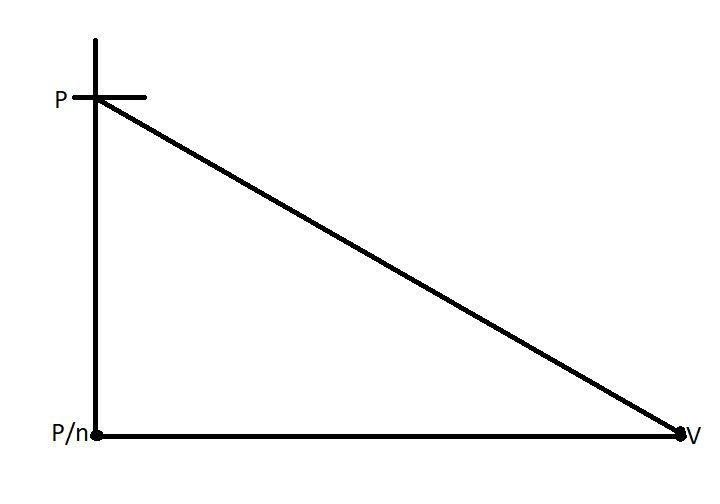Answer
424.2k+ views
Hint: First draw the required graph. Now we see that the pressure is falling from pressure P to P/n, and when pressure is decreasing volume is also decreasing. Now take the formula for ideal gas. Equate those two to find how two gases are related to each other. Then find the value volume of the second gas in terms of the first one and now as per the given conditions apply it in the formula net heat.
Formula used:
PV = nRT, here P is the pressure, V is the volume, n is the number of moles, R is the universal gas constant, and T is the temperature of the gas.
Complete step by step answer:

In the above graph we see that, the pressure is falling from p to $\dfrac{P}{n}$, and as the pressure falls, the volume also decreases to ‘V’.
We know that,
${{P}_{1}}{{V}_{1}}=nR{{T}_{1}}$ and ${{P}_{2}}{{V}_{2}}=nR{{T}_{2}}$,
We also know that this ${{T}_{1}}$and${{T}_{2}}$, both are the same.
So we can write,
${{P}_{1}}{{V}_{1}}={{P}_{2}}{{V}_{2}}$.
Now if we consider${{P}_{1}}{{V}_{1}}=PV$, then
$PV=\dfrac{P}{n}{{V}_{2}}$, as ${{P}_{2}}=\dfrac{P}{n}$ (given).
${{V}_{2}}=nV$.
Now we have to find the net heat,
We know that net heat is= nRT.
Now as off in the first condition:
$nRT=P\Delta V=\dfrac{P}{n}\left( nV-V \right)$,
$\dfrac{P}{n}V\left( n-1 \right)$, now if we replace the PV with nRT, as PV=nRT.
Then we get the result as,
$RT\left( n-1 \right)$,
Thus option D is the correct option.
Note:
An isochoric process is a thermodynamic process in which the volume of the gas remains constant in the system, whereas in the case of an isobaric process the pressure of the system always remains constant.
Formula used:
PV = nRT, here P is the pressure, V is the volume, n is the number of moles, R is the universal gas constant, and T is the temperature of the gas.
Complete step by step answer:

In the above graph we see that, the pressure is falling from p to $\dfrac{P}{n}$, and as the pressure falls, the volume also decreases to ‘V’.
We know that,
${{P}_{1}}{{V}_{1}}=nR{{T}_{1}}$ and ${{P}_{2}}{{V}_{2}}=nR{{T}_{2}}$,
We also know that this ${{T}_{1}}$and${{T}_{2}}$, both are the same.
So we can write,
${{P}_{1}}{{V}_{1}}={{P}_{2}}{{V}_{2}}$.
Now if we consider${{P}_{1}}{{V}_{1}}=PV$, then
$PV=\dfrac{P}{n}{{V}_{2}}$, as ${{P}_{2}}=\dfrac{P}{n}$ (given).
${{V}_{2}}=nV$.
Now we have to find the net heat,
We know that net heat is= nRT.
Now as off in the first condition:
$nRT=P\Delta V=\dfrac{P}{n}\left( nV-V \right)$,
$\dfrac{P}{n}V\left( n-1 \right)$, now if we replace the PV with nRT, as PV=nRT.
Then we get the result as,
$RT\left( n-1 \right)$,
Thus option D is the correct option.
Note:
An isochoric process is a thermodynamic process in which the volume of the gas remains constant in the system, whereas in the case of an isobaric process the pressure of the system always remains constant.
Recently Updated Pages
How many sigma and pi bonds are present in HCequiv class 11 chemistry CBSE

Why Are Noble Gases NonReactive class 11 chemistry CBSE

Let X and Y be the sets of all positive divisors of class 11 maths CBSE

Let x and y be 2 real numbers which satisfy the equations class 11 maths CBSE

Let x 4log 2sqrt 9k 1 + 7 and y dfrac132log 2sqrt5 class 11 maths CBSE

Let x22ax+b20 and x22bx+a20 be two equations Then the class 11 maths CBSE

Trending doubts
Fill the blanks with the suitable prepositions 1 The class 9 english CBSE

At which age domestication of animals started A Neolithic class 11 social science CBSE

Which are the Top 10 Largest Countries of the World?

Give 10 examples for herbs , shrubs , climbers , creepers

Difference between Prokaryotic cell and Eukaryotic class 11 biology CBSE

Difference Between Plant Cell and Animal Cell

Write a letter to the principal requesting him to grant class 10 english CBSE

Change the following sentences into negative and interrogative class 10 english CBSE

Fill in the blanks A 1 lakh ten thousand B 1 million class 9 maths CBSE



